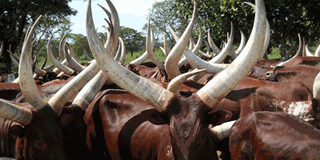Prime
Here is why we should not give up on local breeds of cattle

Although exotic breeds are more efficient, local breeds are more accustomed to the environment. Photo by Michael J. Ssali
There is a growing campaign these days urging farmers to intensify production through modern agriculture as the key to food security and economic development.
Some people however, have interpreted ‘modern agriculture’ as purely about adaptation to the use of hybrid seeds, production of non-traditional food crops, keeping of exotic animals and birds, using manufactured fertilisers and a whole range of other inputs that are often too expensive for the majority of our smallholder farmers.
Balance exotic and local
But even if not all of us can afford the inputs needed for the so-called ‘modern agriculture,’ there are still other ways of intensifying food production by drawing on simple traditional knowledge and sticking to the development of our traditional crops and livestock.
A few weeks ago, in this column, we discussed the need to sustain the production of our indigenous food crops because they are an important part of our history and culture, which we should proudly struggle to improve and pass on to future generations.
The focus in today’s discussion is drawn on the role of indigenous cattle in our economic development and attaining food security and sovereignty.
Due to increased demand for milk and dairy products, resulting from a rapidly growing population and changed feeding habits, many farmers are switching to exotic cows that are known for producing large quantities of milk. One Friesian cow may produce as much milk as 10 indigenous African cows would produce.
But this should not suggest that the indigenous cows be abandoned by all the farmers in preference to exotic cows. Indigenous cows are more adopted to local conditions and are more likely to survive environmental stress, local diseases, and variations in climate.
Local is not bad
They are easier for small-holder farmers to keep because they are less likely to fall sick. The farmers usually have big numbers and their droppings provide plenty of manure that may be used to boost crop production and to make biogas. They are also an important source of milk and meat.
According to a book edited by Helen de Iode, The Future of Livestock Production in Africa’s Dry Lands, published by the International Institute for Environment and Development (IIED) and SOS Sahel International UK, indigenous cattle raised by pastoralists in Kenya is said to be worth $800m a year.
“In Uganda indigenous cattle keepers contribute 8.5 per cent of the country’s Gross Domestic Product (GDP) while in Tanzania the traditional livestock sector produces 70 per cent of the country’s milk, which was 770 million litres in 2006. Because they feed on natural grass and graze under the sun, African cows and goats have the best skins and hides.”
Benefits of local cattle
Figures from the Uganda Bureau of Statistics (UBOS), indicate that in 2008, Uganda had an indigenous cattle population of 10,643,620 and it is estimated that today the figure has gone up to 11,979,488. This is against 765,120 exotic heads of cattle in 2008 and an estimated 861,149 this year.
These figures should clearly indicate that it is the indigenous cattle keepers that provide most of the beef we eat in this country.
With regard to milk, the few thousand exotic cows produced 673,499,564 litres in 2008 while the millions of indigenous cows produced 624,334,096 litres.
This year we expect an estimated 758,029,693 litres of milk from exotic cows and 702,693,525 from our indigenous cows.
Admittedly, indigenous cattle individually produce far less milk than the exotic cows. However, since we have large numbers of them due to their natural adaptation to the East African environment and climatic conditions, together, local cattle breeds provide a fairly large amount of milk.
Their manure boosts crop production, and in some communities, indigenous cattle are used for traction and they are so vital in the overall agricultural and economic development of the country.
They are a major source of income to the farmers who keep them. To some people, keeping indigenous cattle is a form of saving money, and there are many cultural values attached to them such as payment of bride price, traditional worship and ritual sacrifice, and other cultural practices.
Threat of extinction
And, when all is said and done, we have an obligation, as Africans to preserve and promote our cattle breeds, for their great beauty, tasty milk, and also for the fact that they are fellow Africans and our identity. They are called Ankole cows, Karimajong cows, Ganda cows, Nkedi cows, etc.
Findings from the Association for Strengthening Agricultural Research in Eastern and Central Africa, (Asareca) indicate that 47 of the 145 breeds of Sub-Saharan African cattle are at risk of extinction while 22 are already extinct due to genetic erosion and some forms of crossbreeding, which lead to substitution.
This is a very sad trend indeed.
Local Cattle Breed
Boran. These animals have been in Africa for thousands of years, making them well adapted to the living conditions here. They originate from Southern Ethiopia. The female version are usually white but the bulls have a darker colour.
Sanga. Also called the Ankore-Watusi cattle, the Sanga are a result of a cross between longhorned Zebu cattle from Pakistan and India with another ancient Egyptian longhorned breed. They are particularly common in Uganda, Rwanda and Burundi. They have chacteristic long horns, which can grow up to 2.5m, and these are used for protection. Sanga cattle are able to survive on limited water and poor quality pastures.
Zebu. These cattle originate from the Indian subcontinent and have proved successful in tropical conditions, including tropical Africa. They are characterised by a backwards pointing hump.




